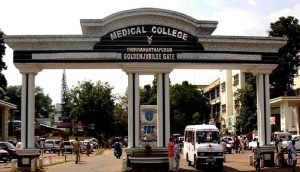
25-11-2017 (Important News Clippings)
To Download Click Here.
![]() Date:25-11-17
Date:25-11-17
गले की हड्डी
टी. एन. नाइनन

वस्तु एवं सेवा कर (जीएसटी) प्रणाली को लेकर आपकी समझ जितनी बढ़ती जाएगी, आप खुद उतना ही ज्यादा यह सवाल पूछेंगे कि क्या यह अर्थव्यवस्था के गले में अटकी हड्डी बन गई है जो न तो उगली जा रही है न ही निगली? काफी कुछ तो इस बात से ही साफ हो जाता है कि कर अपने आप में समस्या नहीं है। बल्कि देश की अर्थव्यवस्था की प्रकृति की वजह से दिक्कत पैदा हो रही है। हमारे यहां छोटे और लघु कारोबारों की तादाद ज्यादा है। इनमें से कई नई कर व्यवस्था की जटिलताओं से तालमेल नहीं बिठा पा रहे हैं या फिर उनको पहली बार कर चुकाना पड़ रहा है या फिर उनको किसी अन्य तरह का नुकसान है। ये सारी बातें मिलकर तमाम विसंगतियां पैदा कर रही हैं। तो क्या जीएसटी केवल उन देशों के लिए बेहतर है जो विकसित हैं, उनके लिए नहीं जहां असंगठित कारोबार ज्यादा हैं? ऐसा नहीं है क्योंकि अच्छी खबर यह है कि जीएसटी से उल्लेखनीय राजस्व हासिल हो रहा है। राज्यों को बजट में उल्लिखित अपना कर हासिल होगा जिसमें गत वर्ष की 14 फीसदी की बढ़ोतरी शामिल है। केंद्र को घाटे का सामना करना पड़ सकता है क्योंकि उसे इस वर्ष केवल 11 महीने का ही राजस्व मिलेगा। परंतु इसके बावजूद उसे ज्यादा नुकसान नहीं होगा। निश्चित तौर पर दरों में कटौती में यह भरोसा छिपा है कि राजस्व में ज्यादा कमी नहीं आएगी। अगर आगे और कटौती की घोषणा की जाती है तो इससे यह पुष्टिï हो जाएगी कि राजस्व के मोर्चे पर निश्चिंतता है। ऐसे में कर संग्रह का पहला लक्ष्य तो पूरा होता दिखता है।
बुरी खबर छोटे और असंगठित कारोबारों से संबंधित है। खासतौर पर उनसे जो निचले स्तर पर कारोबार से जुड़े हैं। इन कंपनियों में से कई का संचालन कर वंचना के जरिये ही होता रहा है। जीएसटी व्यवस्था काफी हद तक कर रियायत की कमियों को दूर करने वाली है। उसने कई कारोबारों को कर दायरे में ला दिया है। यह बदलाव बेहतरी के लिए है और सकारात्मक है। ये तमाम बातें जीएसटी को बेहतर बनाती हैं।परंतु क्या यह व्यवस्था तब भी कारगर साबित होगी जबकि कारोबारी इससे लगने वाले झटकों से उबर रहे हों? छोटे कारोबारियों के लिए यह बदलाव बहुत नुकसानदेह साबित हुआ क्योंकि यह रातोरात हुआ। कुछ बदलाव यकीनन बहुत अधिक दिक्कत पैदा करने वाले हैं। जो छोटे कारोबारी कर की मामूली सपाट दर का चयन करते हैं लेकिन बिना इनपुट क्रेडिट के, उनको नुकसान का सामना करना पड़ रहा है क्योंकि निचले स्तर पर कारोबार से जुड़ी कंपनी बड़े आपूर्तिकर्ता का चयन कर सकती है जो इनपुट क्रेडिट की पेशकश करता हो। वहीं छोटे कारोबारी जो मासिक के बजाय तिमाही रिटर्न फाइल करने के नए विकल्प को चुनते हैं उनको भी तीन महीने के बाद ही कर क्रेडिट मिलेगा। इससे उनकी क्रेडिट आवश्यकता बढ़ेगी। निर्यातकों को भी यही समस्या आई है। एक छोटा कारोबारी मासिक रिटर्न दाखिल कर सकता है या चाहे तो मामूली कर विकल्प को न अपनाने का रास्ता चुन सकता है। तब उसको जीएसटी फाइलिंग व्यवस्था की पूरी कठिन प्रक्रिया का सामना करना होगा।
प्रक्रिया बहुत नुकसानदेह हो सकती है। 70 लाख कारोबारियों में से करीब 25-30 फीसदी ने जीएसटी व्यवस्था को अपनाया है लेकिन वे रिटर्न फाइल नहीं कर रहे हैं। करीब-करीब 40 फीसदी कारोबारियों ने रिटर्न फाइल किया है लेकिन उसमें कर रिटर्न की मात्रा शून्य है। इसके अलावा करीब 95 फीसदी लोग जो चुकता कर की रिपोर्ट फाइलिंग कर रहे हैं उनका औसत भुगतान 20,000 रुपये से ज्यादा नहीं है। कर के उस स्तर पर उनका सालाना टर्न ओवर एक करोड़ से कम है। इस बीच 25-30 फीसदी कारोबारी जो फाइल करने में नाकाम रहे वे भी छोटे कारोबारियों की श्रेणी में आएंगे। लाखों छोटे कारोबारियों की ओर से ऐसे कमजोर फाइलिंग अनुपालन वाली व्यवस्था बड़ी तादाद में सामने आने वाले क्रेता-विक्रेता इनवॉयस से कैसे निपटेगी? अगर लोग फाइलिंग के दौरान चूक करते हैं तो अफरातफरी मचने का पूरा जोखिम है। इन तमाम बातों के बीच यह आधिकारिक स्थिति भी ठीक है कि बिना इनवॅायस के मिलान के जीएसटी अपने मायने ही काफी हद तक खो देगा। उम्मीद की जानी चाहिए कि लाखों कारोबारियों की प्रक्रियागत जरूरतें सामने आने के पहले ही इस व्यवस्था को मूलभूत रूप से सहज बनाया जा सकेगा। पूरी व्यवस्था को खारिज करने के विकल्प के बारे में तो सोचा भी नहीं जा सकता।
आस्था और तर्क के अंधेरे में भटकता समाज
पद्मावती फिल्म पर विवाद से लोकतांत्रिक ताने-बाने को पहुंचे नुकसान के बाद समाधान की तलाश
अरुण कुमार त्रिपाठी, प्रोफेसरएडजंक्ट, महात्मा गांधी अंतरराष्ट्रीय हिंदी विश्वविद्यालय

फिल्म पद्मावतीपर उठा विवाद देखकर लगता है कि भारत आस्था और तर्क के अंधेरे बंद कमरे में भटक गया है। एक तरफ आस्थाविहीन तर्क है तो दूसरी तरफ तर्कविहीन आस्था है। उसे तो दरवाजा मिल रहा है और ही खिड़की। इस विवाद ने हमारी सोच और लोकतांत्रिक ताने-बाने को सिर्फ नुकसान पहुंचाया है, जिसकी पूर्ति होने में समय लगेगा।इसने आस्था की उस डोर को भी खंडित किया है जो कभी भारत के ऋषियों ने बनाई थी और जिसमें डूबकर मलिक मोहम्मद जायसी ने ‘पद्मावत’ लिखा था। ये घटनाएं साबित करती हैं कि तानाशाही तो भय पर चलती ही है लेकिन, लोकतंत्र ने भी निर्भय नागरिकता को तिरस्कृत कर दिया है और उसने सत्य, अहिंसा जैसी अपनी मूल मान्यताओं को खंडित किया है। उसके चुनावी लोभ ने विवेक को खामोशी की नींद सुलाने की तैयारी की है। समाज के प्रतीकों और आस्थाओं पर सवाल खड़ा करने वाले या तो मार दिए जाते हैं या जेल भेज दिए जाते हैं, जबकि सरकार उन लोगों के आगे लाचार लगती है जो अफवाह, आस्था और कुतर्क की तलवारें भांजते हुए असहमति को आतंकित करते हैं।
सवाल उठता है कि समाधान क्या है? कुछ लोग मानते हैं कि सरकारें बदल देने से अफवाह, आस्था और कुतर्क का सहारा लेने वालों की हिम्मत पस्त हो जाएगी और तब यह समस्याएं समाप्त हो जाएंगी। दूसरे लोगों का मानना है कि सवाल चेतना का है और जब तक तथ्य, वैज्ञानिक परीक्षण और तर्क पर आधारित संस्कृति नहीं बनेगी तब तक यह सब होता रहेगा। इसलिए एक प्रकार की सांस्कृतिक क्रांति बेहद जरूरी है। दूसरी तरफ ‘आस्थावादियों’ का मानना है कि पश्चिम की ईसाइयत और मध्यपूर्व की इस्लामी संस्कृति के प्रभाव में भारत की मूल संस्कृति को बहुत आहत किया गया है इसलिए यह सब हो रहा है। इसीलिए इतिहास को फिर से लिख दिए जाने के बाद सब कुछ ठीक हो जाएगा और तब हिंदू संस्कृति की उदारता भी प्रकट होगी।
ये दोनों अलग-अलग छोर हैं और उनके बीच में कोई निर्मल धारा नहीं बहती बल्कि बहुत सारा कचरा है। मीडिया के लाइक, डिसलाइक, कमेंट, ट्वीट, रीट्वीट और टीआरपी के आधार पर तय हो रहा है कि कौन जीता कौन हारा। सत्ता, समृद्धि और प्रसिद्धि की दौड़ में हमारा समाज आस्था और तर्क के अंधेरे बंद कमरे में भटक गया है। उसे मुक्ति का आकाश मिल रहा है और ही चेतना की अतल गहराई, ही मैत्री और सुख-शांति। उसका ज्ञान मात्र सूचनाओं में सिमट गया है और विद्या पैकेज और कॅरियर की दासी हो गई है। किसी में सत्य जानने की इच्छा है और ही साहस। हमारे उच्च शिक्षा संस्थान और उनमें बैठे प्रगतिशील विद्वानों ने अपने ज्ञान और तर्क के प्रति समाज में विश्वास और आस्था विकसित करने का प्रयास नहीं किया और अब तर्कविरोधी और आस्थावादी लोग पाखंडपूर्ण आस्था और निराधार विश्वास को ही ज्ञान घोषित कर रहे हैं। ज्ञान के केंद्रों से दूर बैठा इस देश का ग्रामीण और आदिवासी समाज उतनी घृणा और ईर्ष्या में नहीं जीता जितना इस देश का शिक्षित और उच्चशिक्षित समाज। चाहे प्रगतिशील इतिहास लेखन हो या मिथकवादी इतिहास लेखन दोनों में साजिश के सिद्धांत की एक वेगमयी धारा प्रवाहित होती रहती है। यही धारा एक जाति को दूसरी जाति के और एक धर्म को दूसरे धर्म के विरुद्ध खड़ा करती है। यही इतिहास को मिथक बनाना चाहती है और मिथक को इतिहास। एक तरफ तर्क करने वालों की आस्था है तो दूसरी तरफ आस्थावादियों के तर्क।
ऐसे ही लोगों के लिए रामकृष्ण परमहंस ने ब्रह्मसमाज के प्रकांड विद्वान केशवचंद्र सेन से कहा था, ‘केशव तुम्हारी साधना में आने वाले लोग मुझे दक्षिणेश्वर मंदिर में आने वाले बंदरों के सदृश लगते हैं जो थोड़ी देर तो शांत रहते हैं और बाद में कोई आम के पेड़ पर टूट पड़ता है तो कोई अमरूद, कोई तरबूज तो केला और कंकड़ी नोचने लगता है।’ परमहंस ऐसा इसलिए कह सकें क्योंकि वे पोथी पढ़ने वाले विद्वान नहीं थे। वे सच्ची आत्म अनुभूति वाले संत थे और उनके लिए ईश्वर (प्रकृति) के लौकिक और पारलौकिक रूपों में कोई भेद नहीं था। उनके लिए विभिन्न धर्मों को मानने वाले हिंदू, मुस्लिम, ईसाई में भी कोई भेद नहीं था। जिस अंतरात्मा के माध्यम से सत्य का साक्षात्कार परमहंस करते थे वही पद्धति स्वाधीनता संग्राम और बीसवीं सदी के सबसे बड़े नेता महात्मा गांधी भी करते थे। यही वजह थी कि वे अछूत ब्राह्मण, हिंदू- मुस्लिम और भारतीयों अंग्रेजों में आंतरिक रूप से कोई भेद नहीं करते थे। उनकी अंतरात्मा की आवाज मानवता को लक्षित थी और इसीलिए कभी उनकी आस्था तर्क पर भारी पड़ती थी और कभी उनके तर्क आस्था पर, जिसे कई बार तर्कवादी समझ नहीं पाते थे। जब किसी में मानवता के लिए आस्था पैदा हो जाती तो उनके तर्क समाप्त हो जाते। इसीलिए उनके व्यक्तित्व में संत और राजनीतिज्ञ का अद्भुत मिलन था और वे कह सकते थे कि मैं समस्त हिंदू धर्मग्रंथों में विश्वास करता हूं लेकिन, अपने विवेक के अनुसार उसमें बदलाव की छूट लेता हूं।
आज एक तरफ हमारी वे संस्थाएं हैं जिन्हें संविधान सभा के महान सदस्यों ने निर्मित किया है और लगभग उन्हीं के साथ खड़े हैं वे वस्तुनिष्ठ और तथ्यपरक प्रसिद्ध इतिहासकार जो कहते हैं इतिहास और मिथक को अलग रखना चाहिए। संविधान और तर्क के इसी सिद्धांत के आधार पर यह विमर्श रचा जाता है कि रचनाकार को अधिकतम छूट देनी चाहिए और कला पर प्रतिबंध लगाने की रफ्तार धीमी होनी चाहिए। लेकिन, दूसरी तरफ वे लोग हैं जिनका मानना है कि इस देश के संविधानवादियों और वस्तुनिष्ठ तथ्यपरक इतिहास के रचने वालों ने उनकी परम्परा को नष्ट किया है। उनके जख्मों को भरने का प्रयास ही नहीं किया। भला कोई देश और समाज अपने आर्थिक और सांस्कृतिक विकास के मार्ग में इतनी बड़ी खाई लेकर कैसे आगे बढ़ सकता है। इसका रास्ता उसी अंतःप्रकाश से निकलेगा, जिसे पाकर डिग्रीविहीन भक्तिकाल के सगुण और निर्गुण धारा के कबीर, दादू, रैदास, सूर, तुलसी जैसे तमाम कवि एक दूसरे से बहुत भिन्न रहते होते हुए भी एक-दूसरे के प्रति आदर और प्रेम रखते थे। वे किसी भी व्यवस्था से भयभीत नहीं थे। इतिहास का मकसद तो नए युद्ध की प्रेरणा देना है और ही आस्था का उद्देश्य विरोध के लिए विरोध और पराये की खोज उसके प्रति घृणा पैदा करना है।
देश की नदियों को बचाने की एक नई उम्मीद
ज्ञानेन्द्र रावत, पर्यावरण कार्यकर्ता

बीते दिनों देश की सर्वोच्च अदालत ने महाराष्ट्र की दो नदियों उल्हास और वलधूनी में प्रदूषण करने के लिए राज्य सरकार पर 100 करोड़ रुपये का भारी जुर्माना लगाया है। अदालत ने कहा कि जुर्माने की इस राशि से इन दोनों प्रदूषित नदियों को फिर से उनके मूल स्वरूप में लौटाया जाएगा। वैसे 2015 में राष्ट्रीय हरित अधिकरण यानी एनजीटी ने महाराष्ट्र की इन दोनों नदियों में भारी प्रदूषण करने पर 95 करोड़ रुपये का जुर्माना लगाया था। राज्य सरकार ने एनजीटी के फैसले के खिलाफ मुंबई हाईकोर्ट में अपील दायर की और स्टे ले लिया। इसके बाद ह्यूमन राइट लॉ नेटवर्क ने हाईकोर्ट के फैसले के खिलाफ सर्वोच्च अदालत में अपील दायर की। यह फैसला उस समय आया है, जब नदी प्रदूषण से मुक्ति की उम्मीद अब सरकारों से करना बेमानी हो गया है। यह उस देश में नदियों की बदहाली की तस्वीर है, जहां के लोग नदियों से सांस्कृतिक और पारंपरिक दृष्टि से जुड़े हुए हैं। वे नदियों को मां मानते हैं, उनकी पूजा करते हैं और नदियों में स्नान कर खुद को धन्य मानते हैं। गंगा में डुबकी लगाना तो उनके लिए पुण्य का सबब है, लेकिन आज हमारी ज्यादातर नदियां नाले का रूप अख्तियार कर चुकी हैं, कहीं वे कुड़ाघर बन चुकी हैं, कहीं वह सूख गई हैं, कहीं मौसमी नदी बनकर रह गई हैं और कहीं उनका नामो-निशान तक नहीं रह गया है। इन्हीं हालात के मद्देनजर एनजीटी को यह कहने पर विवश होना पड़ा कि नदियां साफ होने की बजाय बीते सालों में और प्रदूषित होती चली गईं। देश के सबसे बड़े राज्य उत्तर प्रदेश की बात करें, तो यहां की सबसे प्रदूषित नदियों में हिंडन शीर्ष पर है। उसके बाद वरुणा, काली, गंगा और यमुना हैं। हिंडन में ऑक्सीजन का स्तर शून्य रह गया है। नदी में मानक से अधिक बैक्टीरिया होने के कारण इसका पानी जहरीला हो चुका है। इसके अलावा गुजरात की अमलाखेड़ी, खारी, हरियाणा की मारकंदा, मध्य प्रदेश की खान, आंध्र प्रदेश की मुंशी, महाराष्ट्र की भीमा भी प्रदूषित नदियों के मामले में शीर्ष पर हैं।
हालांकि बात जब प्रदूषण मुक्ति की आती है, तो सबसे पहले गंगा और यमुना का जिक्र आता है। गंगा की सफाई पर 1986 से काम जारी है। गंगा एक्शन प्लान इसका प्रमाण है। 2014 में राजग सरकार ने सत्ता में आने के बाद नमामि गंगे परियोजना प्रारंभ की। यह योजना भी 1986 में शुरू हुई तत्कालीन प्रधानमंत्री राजीव गांधी की तरह प्रधानमंत्री नरेंद्र मोदी की महत्वाकांक्षी परियोजना के रूप में जानी गई। इसकी सफलता के लिए केंद्र सरकार के सात मंत्रालयों की साख दांव पर लगी। पहले दावा था कि गंगा सफाई का नतीजा 2018 से नजर आने लगेगा। अब कहा जा रहा है कि गंगा के 150 प्रोजेक्ट मार्च 2018 से अपना काम शुरू करेंगे। इनमें नदी में प्रदूषित पानी को जाने से रोकना व गंदे जल का पुनर्चक्रण कर बिजली से चलने वाले वाहनों के लिए ईंधन के रूप में बायो सीएनजी का उत्पादन करना है। उत्तर प्रदेश के वाराणसी और उत्तराखंड के हरिद्वार में हाईब्रिड पीपीपी मोड में केंद्र, राज्य और निजी कंपनियों के सहयोग से सीवेज शोधन संयंत्र बनाए जाएंगे। इन पर मार्च 2018 में काम शुरू किया जाएगा। ये अगले दो साल में बनकर तैयार होंगे।
यही हाल यमुना का है, जिसे बरसों पहले बड़े जोशो-खरोश के साथ टेम्स बनाने का दावा किया गया था। पर आज भी यमुना में नालों का गिरना बदस्तूर जारी है। एनजीटी यमुना सफाई के मुद्दे पर बार-बार केंद्र, दिल्ली सरकार और दिल्ली जल बोर्ड को चेतावनी दे रहा है। उसने यमुना में कचरा फेंकने पर और यमुना किनारे शौच करने पर प्रतिबंध लगाया और उल्लंघन करने पर 5,000 रुपये दंड भी लगाया, पर बात ज्यादा आगे नहीं बढ़ी। नदियों के अस्तित्व की रक्षा के लिए सिर्फ सरकारी प्रयास ही नहीं, बहुत सारे आंदोलन भी हुए। साधु-संत और स्वयंसेवी संगठनों द्वारा यात्राएं भी निकाली गईं। कुंभ जैसे अवसरों पर भी नदियों को बचाने के संकल्प लिए गए। लेकिन कोई नतीजा निकलता नहीं दिखाई दिया। ताजा फैसले से सुप्रीम कोर्ट ने जरूर एक उम्मीद बंधाई है। यह माना जा रहा है कि इससे नदियों की सफाई का एक बड़ा रास्ता खुलेगा। हालांकि जिम्मेदारी फिर भी उन्हीं सरकारों पर होगी, जो अभी तक इससे बचती आई हैं।
 Date:24-11-17
Date:24-11-17
Partnership of ideas
Digitisation provides an opportunity to strengthen industry-academia ties.
Rana Kapoor, MD & CEO, Yes Bank, and chairman, Yes Global Institute.

Turning learning into action and outcomes is perhaps the greatest challenge for all stakeholders in education. Businesses, even in the most mundane commoditised sectors, today depend upon their ability to innovate to survive and grow. Moreover, innovation is not limited to businesses, governments and non-profits are also actively looking for innovative solutions to social and global challenges.India had excellent research traditions through its iconic centres of learning in ancient times. These traditions, however, have not been able to keep up. The interface between academia and industry is today benchmarked with the most dynamic ecosystems seen in the US, Germany and Japan. Countries like China have seen a quantum increase in academia-driven research to sustain the strong momentum demonstrated in its economy .The new challenge will be to motivate young minds to innovate, especially in keeping with the demands of industry. This brings collaboration to the forefront.
With the new age economy powered by digitisation and disruptive technologies, the industry-academia relationship is undergoing a rapid transformation. As we move to multidisciplinary job roles, corporates now support incubators and accelerators instead of grants to academic research. One of the best examples in India is the Centre for Innovation, Incubation and Entrepreneurship (CIIE), supported by the Centre, state governments and industry, to promote innovation. Also, post-recruitment on-the-job training is giving way to apprenticeship for hands-on training. The government’s recent drive to enhance the scope and scale of apprenticeship through the NAPS (National Apprenticeship Promotion Scheme) is a step in the right direction.However, despite the recent momentum, we have a long way to go. Other than a few islands of excellence (mostly IITs and IISc), research in India degenerates into academic sloth with little encouragement from industry or government. In terms of funding, industry contribution to research even at the IITs is, at 10-15 per cent, far below global standards. In the absence of an active interface between industry and academia, the chances of innovative ideas being absorbed for commercialexploitation are low. This impacts the country’s global competitiveness and its place in the global knowledge economy. To address these challenges, we need a four-pronged approach.
First, India needs to achieve global standards in universities’ governance. Universities need to be given academic, administrative and financial autonomy to evolve as functional ecosystems of research, innovation and entrepreneurship. It is extremely important to harness the budding entrepreneurial energy of students for greater socio-economic development. The autonomy door shall also open much more space for innovative industrial tie-ups.
Second, the breadth of research collaborations needs to expand to cover a respectable percentage of the total institutions. At least 100 institutions should be actively engaged as “research” institutions, up from the current 10 (mostly IITs and IISc). One way to enable such an expansion is to open research funding to all eligible institutions on merit instead of limiting all public funding to government institutions. Moreover, individual states have to evolve their own vision so that some state universities are prepared to take on sector-specific research complementing their industrial clusters.
Next, apprenticeship needs to catch up. India has only 30,000 enterprises registered for taking apprentices compared to Germany which has more than 2,00,000 enterprises for apprentices. The apprenticeship drive is an effective means of promoting industry academia collaboration.The spirit of research and innovation needs to be inculcated at an early age at the school level to build a strong base for illuminated industrial minds. The setting up of “tinkering” labs at 1,000 schools under the Atal Innovation Mission through the efforts of the government and the private sector is an excellent initiative in this regard. However, we need to scale-up such initiatives a thousand times more to create a great impact. China, for instance, has installed 3D printers in all its elementary schools to prepare a generation adept at using next-generation technology.
Finally, there is a need for a quantum increase in funding to research. India commits just 0.8 per cent of its GDP in PPP terms to research compared to 2.7 per cent, 2.9 per cent and 2.1 per cent by innovation hubs like the US, Germany and aspiring powers like China. The PM’s recent announcement to provide Rs 10,000 crore to top 20 public and private universities over the next five years to make them world class research universities is an excellent initiative. In terms of funding support from industry, India’s average industry income per academic is less than one-fourth of the top performing countries — Germany, the US and China. This can be addressed by promoting a culture of monetising intellectual property at our universities.India has an opportunity to reform and transform its broken industry-academia interface as this relationship takes new shape to reflect the needs of the digital economy. Multiple academic and socio-economic objectives can be targeted through this partnership. The culture of industry and technology can best be harnessed at the university level which can seamlessly create a fusion of ideas. We must not miss the bus this time.
Going universal
Karnataka does well to finalise the road map to ensure universal health coverage
EDITORIAL

Karnataka’s move to amend the law governing private medical establishments is a logical step in its plan to provide universal health coverage in the State. There can be a debate on how individual aspects of medical services are best regulated, but laying down standards, containing treatment costs, mandating transparency and creating a binding charter that empowers patients are all basic components of healthcare reform. The State government has wisely dropped the clause on imprisonment for medical negligence in the final draft of the amendment Bill, avoiding a possible delay in broadening the scope of the Karnataka Private Medical Establishments Act, 2007. There is a need, of course, to ensure parity in services offered by government and private institutions, and end the neglect of public facilities especially in rural areas. The transition to universal health access, provided free at the point of delivery, must be a national priority as it is the key Sustainable Development Goal relating to health to be achieved by 2030. The UPA government dropped the ball midway, although it had a report from an expert group of the Planning Commission in 2011 proposing a road map for universal coverage. Karnataka is pursuing needed reform in some of the areas covered by the expert panel, notably on containing the cost curve in establishments that operate for profit and where patients with state-supported insurance get treated.
The task before Karnataka now is to come up with an essential health package consisting of treatments available to all and to devise ways to charge users based on the ability to pay. Capping costs for those who use such facilities is important, given that out-of-pocket expenditure on health in India is extremely high. Regulation of prices for some drugs may have had a moderating effect, but much work remains to be done to streamline processes to achieve centralised procurement and free distribution of essential medicines to all. Karnataka’s decision to set up a regulator for government hospitals is a response to the criticism that nothing is being done to raise standards in these institutions and bring in accountability. Ideally, all health institutions participating in a universal access programme should be governed by common regulations, for which national, State and district-level authorities are the answer. Such a comprehensive approach can eliminate fragmentation of functions. Also, the public health approach at the primary level should not be lost sight of, while focussing on reform of hospital-based care. National schemes aimed at reducing the burden of infectious and non-communicable diseases, and improving the health of women and children, should continue to receive top priority.
